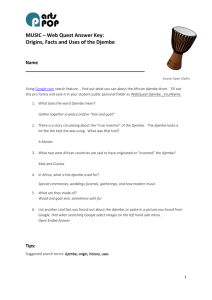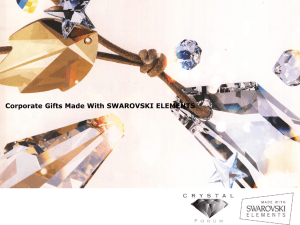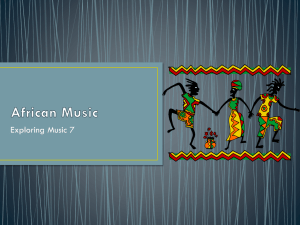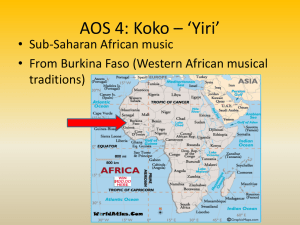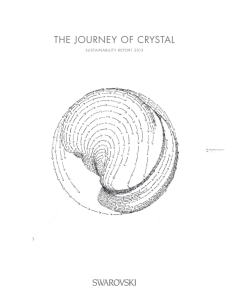Djembe Drums of West Africa
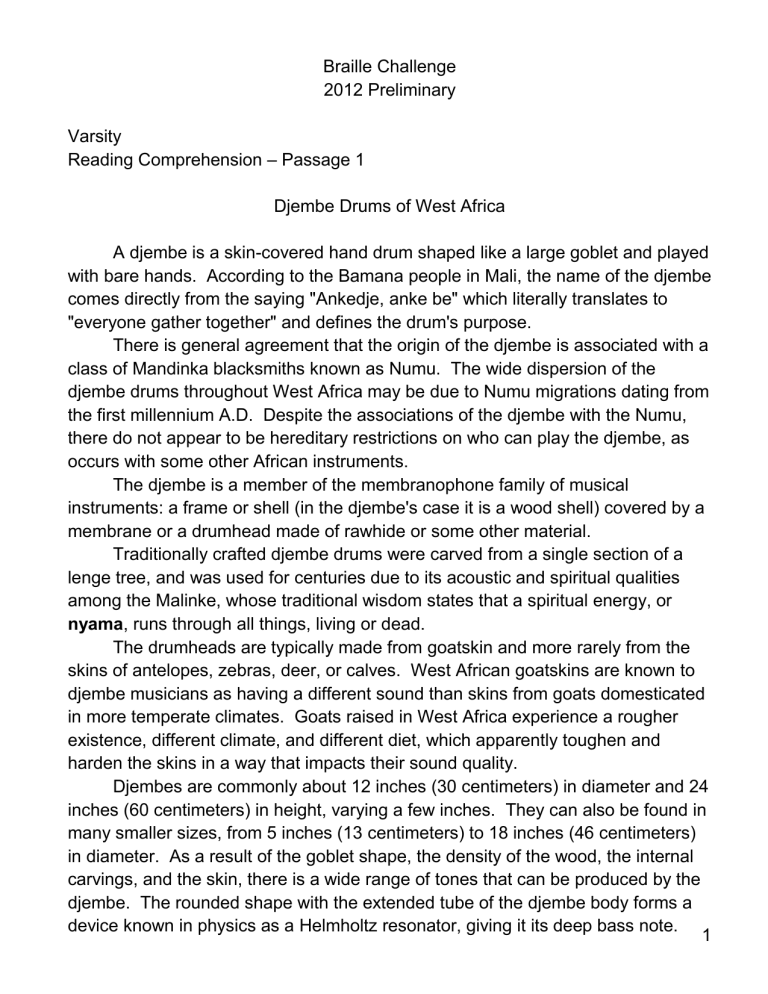
Braille Challenge
2012 Preliminary
Varsity
Reading Comprehension – Passage 1
Djembe Drums of West Africa
A djembe is a skin-covered hand drum shaped like a large goblet and played with bare hands. According to the Bamana people in Mali, the name of the djembe comes directly from the saying "Ankedje, anke be" which literally translates to
"everyone gather together" and defines the drum's purpose.
There is general agreement that the origin of the djembe is associated with a class of Mandinka blacksmiths known as Numu. The wide dispersion of the djembe drums throughout West Africa may be due to Numu migrations dating from the first millennium A.D. Despite the associations of the djembe with the Numu, there do not appear to be hereditary restrictions on who can play the djembe, as occurs with some other African instruments.
The djembe is a member of the membranophone family of musical instruments: a frame or shell (in the djembe's case it is a wood shell) covered by a membrane or a drumhead made of rawhide or some other material.
Traditionally crafted djembe drums were carved from a single section of a lenge tree, and was used for centuries due to its acoustic and spiritual qualities among the Malinke, whose traditional wisdom states that a spiritual energy, or nyama , runs through all things, living or dead.
The drumheads are typically made from goatskin and more rarely from the skins of antelopes, zebras, deer, or calves. West African goatskins are known to djembe musicians as having a different sound than skins from goats domesticated in more temperate climates. Goats raised in West Africa experience a rougher existence, different climate, and different diet, which apparently toughen and harden the skins in a way that impacts their sound quality.
Djembes are commonly about 12 inches (30 centimeters) in diameter and 24 inches (60 centimeters) in height, varying a few inches. They can also be found in many smaller sizes, from 5 inches (13 centimeters) to 18 inches (46 centimeters) in diameter. As a result of the goblet shape, the density of the wood, the internal carvings, and the skin, there is a wide range of tones that can be produced by the djembe. The rounded shape with the extended tube of the djembe body forms a device known in physics as a Helmholtz resonator, giving it its deep bass note.
1
Today in Africa, continuing a long tradition, an individual needs to spend many years accompanying his master in ceremonies and other festivities before becoming a real djembefola (djembe player).
Questions for “Djembe Drums of West Africa”
1. The djembe head is made of _____ a. wood. b. skin. c. metal. d. glass.
2. Djembes are meant to be played _____ a. by Africans. b. by blacksmiths. c. with bare hands. d. with mallets.
3. “Everyone gather together” implies the djembe is a(an) _____ instrument. a. inherited b. resonant c. difficult d. communal
4. Compared with goats in other parts of the world, those in West Africa
experience all of the following EXCEPT _____ a. a temperate climate. b. toughened skin. c. a rougher existence. d. a unique diet.
5. What is a characteristic of the djembe that helps it produce a wide variety of
tones? a. its external carvings b. the ratio of its width to its height c. the density of the wood d. all of the above
2
6. When an individual begins playing the djembe, she or he plays _____ a. alone. b. in a group of djembe players. c. with a master. d. none of the above.
7. The difference between the diameters of the largest and smallest djembes
mentioned in this passage is _____ a. 24 inches. b. 30 inches. c. 12 inches. d. 13 inches.
8. A synonym for nyama is _____ a . ankedje, anke be. b. everyone gather together. c. spiritual energy. d. membranophone.
9. Numu migrations were partly responsible for _____ a. the proliferation of djembe drums throughout West Africa. b. the wide variety of woods used to craft djembe drums. c. hereditary restrictions placed on who can play the djembe drum. d. the use of different types of goatskins to produce different tones.
10. What enables a djembe to produce deep bass notes? a. its wide diameter b. its goblet shape c. its internal carvings d. the density of its wood
3
Braille Challenge
2012 Preliminary
Varsity
Reading Comprehension – Passage 2
Swarovski Crystals
Swarovski is the brand name for a range of precisely-cut crystal and related luxury products produced by the Austrian company, Swarovski AG.
Daniel Swarovski (October 24, 1862 – January 23, 1956) was born in northern Bohemia, an area that is now the Czech Republic. His father was a glass cutter who owned a small glass factory. It was there that young Swarovski served an apprenticeship, becoming skilled in the art of glass-cutting. In 1892 he patented an electric cutting machine that facilitated the production of crystal glass. Three years later, the Swarovski company was founded. The company established a crystal cutting factory in Wattens, Austria, to take advantage of local hydroelectricity for the energy-intensive grinding processes Daniel Swarovski patented.
The Swarovski Crystal range of products includes crystal glass sculptures and miniatures, jewelry , home décor items, and chandeliers. To create crystal glass that lets light refract in a rainbow spectrum, Swarovski coats some of its products with special metallic chemical coatings. Aurora Borealis (AB), which gives the surface a rainbow appearance, is one of the most popular coatings.
All Swarovski creations are marked with a logo, which has changed over time. The original logo of an edelweiss flower was replaced by the initials “S.A.L.”.
In 1988, the company adopted the current logo depicting the image of a swan.
The company runs a crystal-themed indoor park, Swarovski Kristallwelten
(Crystal Worlds), at its original Wattens site near Innsbruck, Austria. The Crystal
Worlds center is fronted by an enormous grass-covered head, the mouth of which is a fountain. Crystal Worlds houses exhibitions related to, or inspired by, the crystals — but do not include explanations of how the famous designs are made, produced or finished.
Questions for “Swarovski Crystals”
1. Which synonym of facilitated would best match its use in this passage? a. loosened up b. smoothed c. unclogged d. eased
1
2. Swarovski’s original crystal cutting factory was in _____ a. The Czech Republic. b. Bohemia. c. Austria. d. Germany.
3. Swarovski established a crystal-cutting factory in Austria for what purpose? a. to take advantage of local hydroelectricity b. to obtain patent rights c. to establish an indoor park d. to grow edelweiss
4. How old was Swarovski when he patented his glass-cutting machine? a. 26 b. 30 c. 60 d. 95
5. To refract light means to _____ a. change the direction of light. b. converge light rays. c. absorb light. d. expend energy.
6. Why does the Swarovski Kristallwelten not include explanations of how the
crystals are made, produced, or finished? a. A book about the process of crystal production is available in the gift
shop. b. The production of crystals is too complicated for most museum visitors to
understand. c. The company wants to keep its methods a secret from competitors. d. Signs describing the production of crystals would detract from the beauty
of the crystals themselves.
7. Which design was the second Swarovski logo? a. the Swarovski name b. the initials S.A.L. c. the swan d. the edelweiss flower
2
8. Why might the company have named its most popular coating “Aurora
Borealis”? a. to give it a distinctive Latin name b. to conjure up the image of a rainbow and its spectrum of colors c. to commemorate a famous artist who worked with crystals d. to compare it to the meteorological phenomenon of the northern lights
9. Why would Swarovski have patented his crystal cutting device? a. to let people in other countries know about it b. to keep other people from copying it and making money c. to keep the crystal production process a secret d. to register his invention with the government for tax purposes
10. Owning a genuine Swarovski crystal might be considered _____ a. a necessity. b. a responsibility. c. a luxury. d. an obligation.
3
